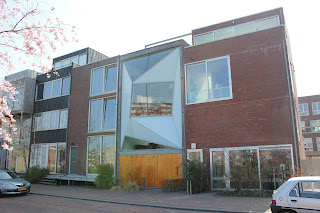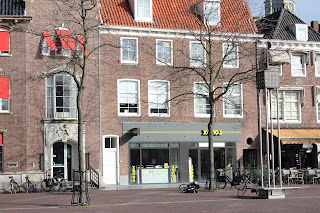Pilot
Study Middelburg: Economic Geography of the Market Square in Middelburg, The Netherlands
Introduction
In
2004, the university Roosevelt Academy was established in Middelburg. At this
moment, seven years later, the student population consists of ±600 people.
Located at the middle of the city center, it can be assumed that the students
of RA contribute to the incomes of the local businesses. Moreover, research
done by Prof. Karas actually indicates that Roosevelt Academy students add
€12.7 million to the turnover of these shops (Karas & Schoors, 2010). With
their convenient locations on the market square, some business benefitted
hugely of the establishment of RA in the old town hall. Especially businesses
close to RA must have experienced a difference due to the influx of students.
Thus,
it is interesting to question if anything has changed for these businesses ever
since RA students started to invade Middelburg. Obviously, Middelburg is known
for their great amount of (German) tourists, and therefore it can be argued
that, especially during the summer, businesses are mainly interested in these
tourists. However, during winter time, not that many tourists visit Middelburg,
and then the businesses interest in the students might raise. Therefore, the following
research question was posed:
To what extent has the economic
geography of the Market Square in Middelburg changed since the establishment of
Roosevelt Academy?
Method
Specific
consumer stores on the Market Square in Middelburg were selected and employees
were asked specific questions as to whether or not RA has made a difference to
their businesses.
Three
businesses that are closest to RA were strategically selected, and three businesses
that are on the other side of the market square (further away but still central
to the market atmosphere) were selected. These businesses are the following:
Seventy-Seven, De Vriendschap, A’Domani, Kippie, Xenos and De Huifkar. We
divided them in a Southern area, including Seventy-Seven, De Vriendschap and
A’Domani, and a Northern area, including Kippie, Xenos and De Huifkar.
Interviews
were conducted at each of these locations and three questions were posed to the
people that worked there. Firstly it was asked how long the business has
existed. If it had existed longer than that RA has then it was asked if they
had noticed a higher influx of students for their business. If it was only
established after students came into the city, it was asked whether the fact
that students are present in Middelburg influenced their decision to open the
business. Secondly it was asked if they
had ever resorted to making special offers or student discounts for RA. Lastly it
was asked if they noticed a trend in specific days at which students come or if
they noticed that higher populations of RA students come at certain times, in
for instance high seasons.
Results
A’
Domani
A’ Domani is
situated in the Southern part of the square. It was started in the summer of
2010, knowing that RA was in Middelburg. Their main clients are tourists, but
this is mainly during the summer months. During the winter it is quieter, but
the RA students compensate well during class breaks for buying coffee and
sandwiches. They do sometimes have special offers such as a sandwich and a
coffee. You can also receive a loyalty card, by which after ten purchased
coffees, the tenth is free. This way, they try to get many students to come.
Seventy-Seven
Seventy-Seven is
situated in the Southern part of the square. This bar was set up in 1977, and has
profited nicely from RA students since their arrival in 2004. Although their
clientele exists of loyal non-RA customers, they have noticed a difference
since RA was set up in 2004. Especially during Tuesday nights, the traditional
party night Roosevelt Academy students, they notice many students coming in. Seventy-Seven does not make special
student prices or deals; however special nights can be arranged. An example of
this can be found in the fact that twice a year, they host a big party thrown
by a RA fraternity and a sorority.
De
Vriendschap
Restaurant
De Vriendschap is situated in the
Southern part of the square. They have been in business for the better part of
14 years and have noticed RA students sitting down for a meal or for a drink
sometimes. Especially in the summer, when the weather permits, the terrace of de Vriendschap gets filled up with
students enjoying the sun. With regards to special offers, what they allow is
to book a certain night with a group for occasions such as Christmas dinner, or
birthday celebration. They have also recently hired RA students as part of
their staff.
Kippie
Kippie
is a take away franchise in the Northern part of the square, at which one can
order meals and sandwiches to eat at home or on the go. They were established
in 2009, five years after RA was established. The manager did not notice a
specific high amount of RA costumers. He stated that he also had some scholars
from high schools coming for sandwiches, and that he did not notice any
difference between students of these high schools and RA students. He also
stated that this year, there are less scholars/students coming to Kippie than the year before. He thought
it also had to do with the establishments of various other sandwich stores in
Middelburg. Since Kippie is a
franchise, the manager is not able to make any specific deals regarding RA
students. They do have special sandwich deals; customers can then buy a
sandwich for only one euro. The manager considers this as attractive for
students.
Xenos
Xenos is also
located in the Northern area, and it is a franchise organization as well, but
they do not sell prepared food. They mostly sell furniture, kitchen equipment,
accessories, but also food items such as pasta, drinks, chocolate, etcetera.
Even though Xenos is situated in the Northern
area, it is still very close to the RA buildings if students come from the
other side of the building. During class breaks, many students go there to get
a cheap drink or snack. An employee of the Xenos
explained that the store was already there long before RA was established. She
herself also worked at the Xenos before RA was established, and she did notice
a specific change of a higher influx of RA students: “Many students come in
here to buy something for their homes, or they come to buy food in their
break.” Since Xenos is a franchise, they cannot make any specific deals
regarding RA students.
De
Huifkar
Restaurant De
Huifkar is also situated at the Northern side of the Market Square. It was
established before RA was established, and the employee that was interviewed
also worked there already before the establishment of RA. This employee told us
that they mostly saw tourists as their most important group of costumers.
Sometimes students come there for a drink, or a sandwich, but mostly in the
summer, when they can sit on the terrace. They do not have any specific deals or
discounts aimed at students, because, as the employee explained, there are too
few students who show interest in having lunch or dinner at De Huifkar.
Conclusion
The presence of students certainly had an impact in the
development of business on the market square in Middelburg. Specifically venues
that lie close to the academic buildings of Roosevelt Academy have experienced
an increase in their business. A’ Domani,
Seventy-Seven, De Vriendschap and Xenos
all stipulated that since the establishment of RA, especially business in the
less touristy season has gone up. Coffee breaks give just enough time to get a
coffee at A’ Domani or buy some food
at Xenos, and managers at these
stores also stressed that students tend to do this. In the case of A’ Domani, this makes it a large part of
their business during the quiet winter season, when selling ice cream is not
feasible.
Both De Vriendschap
and Seventy-Seven come most into
contact with students in the summer. As soon as the sun emerges from behind the
clouds, terraces are filled up with students. But also with dinners, lunches
or, after studying is done, drinks, both the café and the restaurant notice an
increase in business with the advent of students.
However, small businesses that lie farther away from RA
on the northern side of the market square, such as De Huifkar and Kippie, do
not notice as much of the students as the businesses closer to RA. Although
both occasionally run into students sitting at their terrace or buying a
sandwich, this happens not as regularly as with the other venues we
investigated. A reason for this might be that these places are further away
from the RA buildings than the other four, and that the regular 10-minute break
of Roosevelt Academy classes makes students feel that they cannot go too far to
get a sandwich, a coffee or a snack.
In summary, the establishment of RA only positively
influenced the businesses around the market square that we investigated. In
terms of economic geography, some local businesses even grew dependent on
students, such as the opening of A’
Domani in the quiet winter months. Thus, the findings of the research by
Karas and Schoors (2010) are in line with the development of the market square
since the establishment of Roosevelt Academy. They take up a part of the €12.7
million that, as research indicated, Roosevelt Academy brings to Zeeland. This
research also found that RA adds 0.1 percent to the regional domestic product
of Zeeland. But, as this research indicates, the businesses at the market
square of Middelburg depend for a larger percentage on Roosevelt Academy.
References
Karas, A. &
Schoors, K. (2010). Zeeland
and RA. Research by Roosevelt Academy and Ghent
University, as found in: Seven Years Down
the Road, Roosevelt Academy (2012). Retrieved on February 15th,
2012 from: http://roac.nl/roac/_files/req_files/SevenYears_web.pdf

































